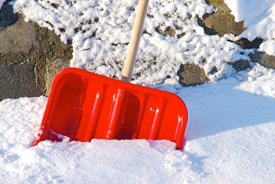Clearing snow
Communities and property owners can help themselves and improve the safety of their area by undertaking simple snow clearance activities as soon as snow falls.
Will I get sued?
- No
- There is no law to prevent the clearing of snow outside your house or on the pavement.
- Occupiers of properties have a legal responsibility to ensure their paths are safe to prevent visitor injuries.
The snow code
- Don’t be afraid to clear paths in fear someone will get injured.
- People walking on snow and ice have the responsibility to be careful.
- Don’t make the pathways more dangerous by causing them to refreeze.
Gritting and clearing pavements and residential areas
What can I use?
- Grit and sharp sand
- Dishwasher salt
- Table salt
- Soda crystals.
Suitable tools
- Plastic lightweight shovel
- Regular shovel - however the snow will stick and be less efficient.
- Domestic grass seed spreader
- Scoop or trowel
- Wheelbarrow to move tools or snow
How much salt?
- Less than you think!
- A small handful should clear and protect 1m (3ft) of surface.
- Therefore to treat 400m (1320ft) of pavement, a 20kg bag of salt will be sufficient.
How to grit your path
- Clearing snow enables the sun to aid the melting and evaporation process throughout the day.
- Salt helps prevent the re-freezing of water that can create black ice.
- Clear a path using a shovel and remove the snow.
- Place salt on a small trowel and shake some off as you walk along, alternatively, use a seed spreader for quicker, more efficient spreading.
- Remember: salt DOES NOT remove snow or compacted ice. Using lots of salt is unnecessary, wasteful, and harmful to the environment.
Tackling compacted snow
- Provide traction for people walking over compacted snow by spreading sand that will become embedded and provide grip.
- Use a coarse cheap sand, such as builder’s sand, cat litter, or cinders. Remember to sweep the pavement after the thaw has occurred.
Look after yourself
Clearing snow is hard work, so ensure you take plenty of breaks and know when to stop. Wear suitable clothing, including boots and warm waterproof clothing.
Snow clearing guide
Prepare your pavement
- If you know it is likely to snow pre-treat your pavement.
- Keep the salt and clearing materials in a location that will remain accessible during snow.
Prepare yourself
- Wear warm clothing and suitable footwear.
- Wear a reflective vest / jacket if working near a road.
- Inform someone how long you intend to be and take a mobile phone with you.
- Inform friends and family of any changes in location or return time.
Clear a path
- Clear the snow in the morning before people start walking and compacting the snow.
- Do NOT use water! Take care when moving snow.
- Deposit snow in verges or front gardens, NOT in drainage gullies.
- Be a good neighbour, offer to clear neighbours’ paths.
Quick guide
- Pre-salt the pathways before the snow.
- Clear the snow and ice early in the day.
- Use salt or sand not water.
- Take care when you move the snow.
- Offer to clear neighbour’s paths.
Need more information?
- For information on gritted roads: Salting, gritting and snow clearance | Oxfordshire County Council
- For live updates follow us on Twitter: @OxfordshireCC
